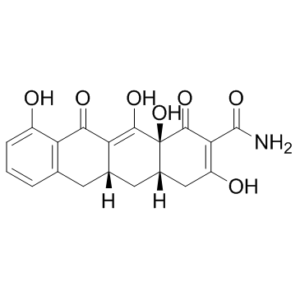This product is for research use only, not for human use. We do not sell to patients.

| Size | Price | Stock |
|---|---|---|
| 100mg | $1250 | Check With Us |
| 250mg | $1950 | Check With Us |
| 500mg | $2925 | Check With Us |
Cat #: V4106 CAS #: 15866-90-7 Purity ≥ 98%
Description: Incyclinide (formerly known as CMT-3 and COL-3; 6-demethyl, 6-deoxy, 4-dedimethylamino TC; a chemically modified tetracycline) is a matrix metalloproteinase (MMP) inhibitor, it acts by inducing extracellular matrix degradation, and inhibiting angiogenesis, tumor growth and invasion, and metastasis.
Publications Citing InvivoChem Products
Product Promise

- Physicochemical and Storage Information
- Protocol
- Related Biological Data
- Stock Solution Preparation
- Quality Control Documentation
| Molecular Weight (MW) | 371.34 |
|---|---|
| Molecular Formula | C19H17NO7 |
| CAS No. | 15866-90-7 |
| Storage | -20℃ for 3 years in powder formr |
| -80℃ for 2 years in solvent | |
| Solubility In Vitro | DMSO: ≥ 100 mg/mLr |
| Water: N/Ar | |
| Ethanol: N/A | |
| SMILES Code | O=C(C1=C(O)C[C@@](C[C@@]2([H])C(C(C3=C(O)C=CC=C3C2)=O)=C4O)([H])[C@@]4(O)C1=O)N |
| Synonyms | COL3; COL-3; COL 3; CMT-3; CMT 3; CMT3; Incyclinide; 4-dedimethylamino sancycline; Chemically modified tetracycline-3. Trade name: Metastat. |
| Protocol | In Vitro | Incyclinide has been shown to experimentally suppress prostate cancer, colon adenocarcinoma and melanoma invasiveness in cell culture. Adding incyclinide at final concentrations of 5 to 20 μM inhibits MT1-MMP gelatinolytic and caseinolytic activity, blocks MT1-MMPactivation of pro-MMP-2, and decreases invasiveness of HT-1080 fibrosarcoma cells. |
|---|---|---|
| In Vivo | Incyclinide inhibits tooth movement in the rat, probably by reducing the number of osteoclasts at the compression side. This might be due to induction of apoptosis in activated osteoclasts or reduced osteoclast migration. Reduced MMP activity by incyclinide might also directly inhibit degradation of the organic bone matrix. |
| Solvent volume to be added | Mass (the weight of a compound) | |||
|---|---|---|---|---|
| Mother liquor concentration | 1mg | 5mg | 10mg | 20mg |
| 1mM | 2.6929 mL | 13.4647 mL | 26.9295 mL | 53.8590 mL |
| 5mM | 0.5386 mL | 2.6929 mL | 5.3859 mL | 10.7718 mL |
| 10mM | 0.2693 mL | 1.3465 mL | 2.6929 mL | 5.3859 mL |
| 20mM | 0.1346 mL | 0.6732 mL | 1.3465 mL | 2.6929 mL |
This equation is commonly abbreviated as: C1 V1 = C2 V2
- (1) Please be sure that the solution is clear before the addition of next solvent. Dissolution methods like vortex, ultrasound or warming and heat may be used to aid dissolving.
- (2) Be sure to add the solvent(s) in order.




































